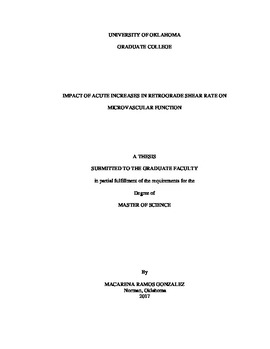| dc.description.abstract | Background: Research had well examined the influence of different levels of retrograde shear stress on macrovascular endothelial function. Data showed a negative impact on flow-mediated dilation (FMD), leading to macrovascular endothelial dysfunction and pro-atherosclerotic mechanisms. However, the impact of retrograde shear on microvascular function, measured in terms of microvascular reactivity, was missing in scientific literature.
Primary Aim: Determine the effect of acute changes in retrograde shear rate on microvascular function in healthy, young humans as determined via the post-occlusive NIRS response.
Methods: 17 healthy subjects participated in this study. Microvascular reactivity, via NIRS derived measurements of tissue oxygenation characteristics, was assessed in each participant before and immediately after exposure to a 30 min retrograde shear treatment. Retrograde shear treatment was achieved via a blood pressure cuff placed below the knee inflated to the target pressure of 75 mmHg. Only one leg of the subject was exposed to the shear stress treatment, with the contralateral leg serving as a control leg, which allowed comparisons between legs.
Results: In the treatment leg, the application of the external cuff resulted in significant increases in retrograde shear stress and an increase in the oscillatory shear index, not observed in the control leg. After acute exposure of the increased retrograde shear stress, the NIRS showed a significantly higher resting TSI% post-intervention in the treatment leg, as well as increases in [Hb]total and [HbO2] resaturation rates and peak TSI%, which were not present in the control leg.
Conclusions: The hypothesis that retrograde shear treatment would affect negatively microvascular function by decreasing the rate of resaturation, time-to-peak resaturation, and peak saturation, was rejected. The data however suggests that our intervention in the treatment leg had a positive impact on NIRS derived parameters of microvascular reactivity. | en_US |
